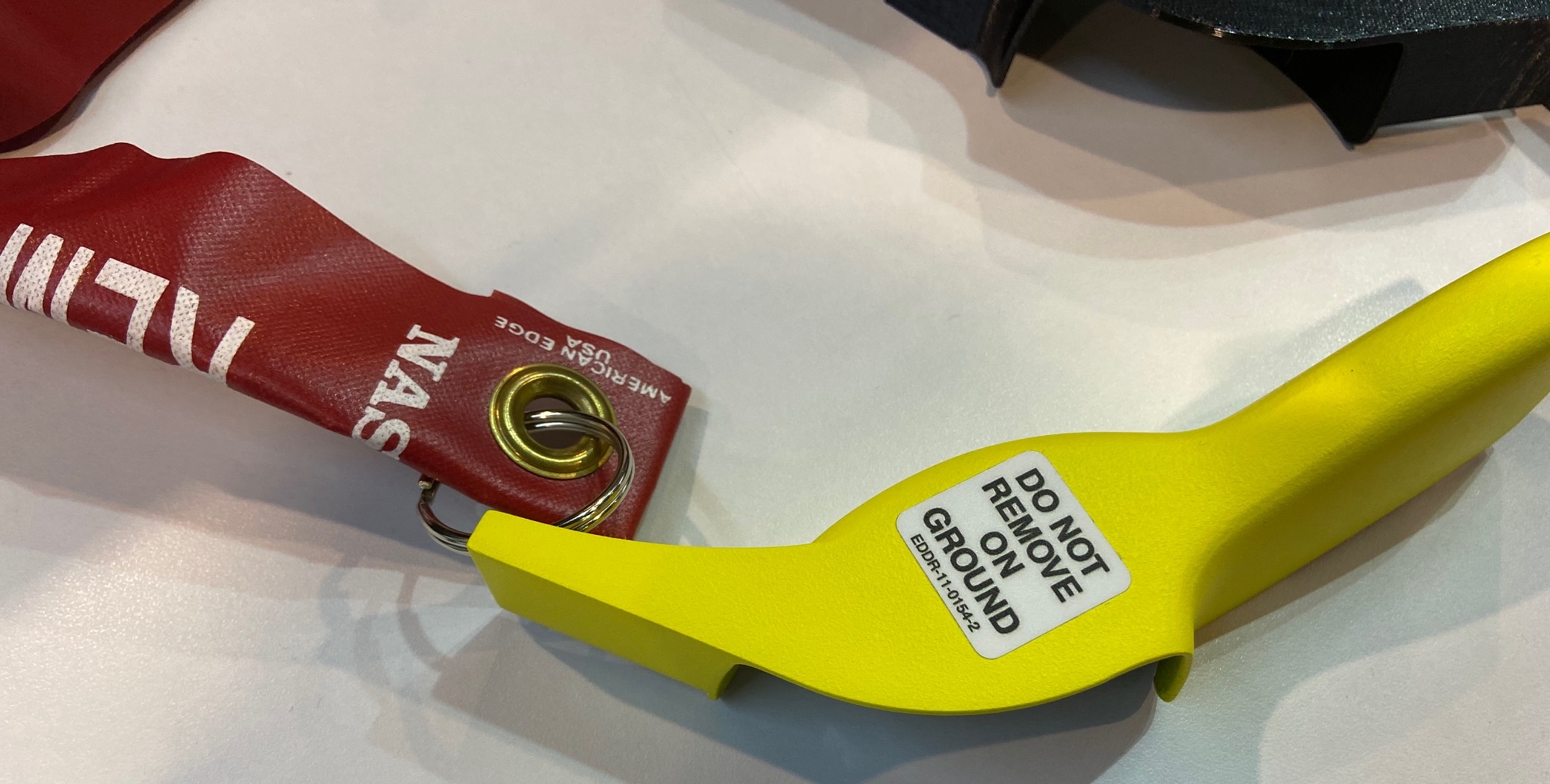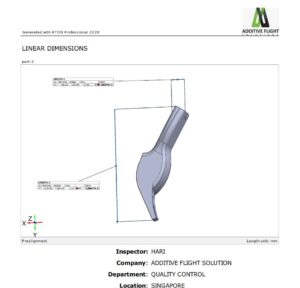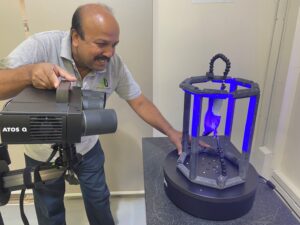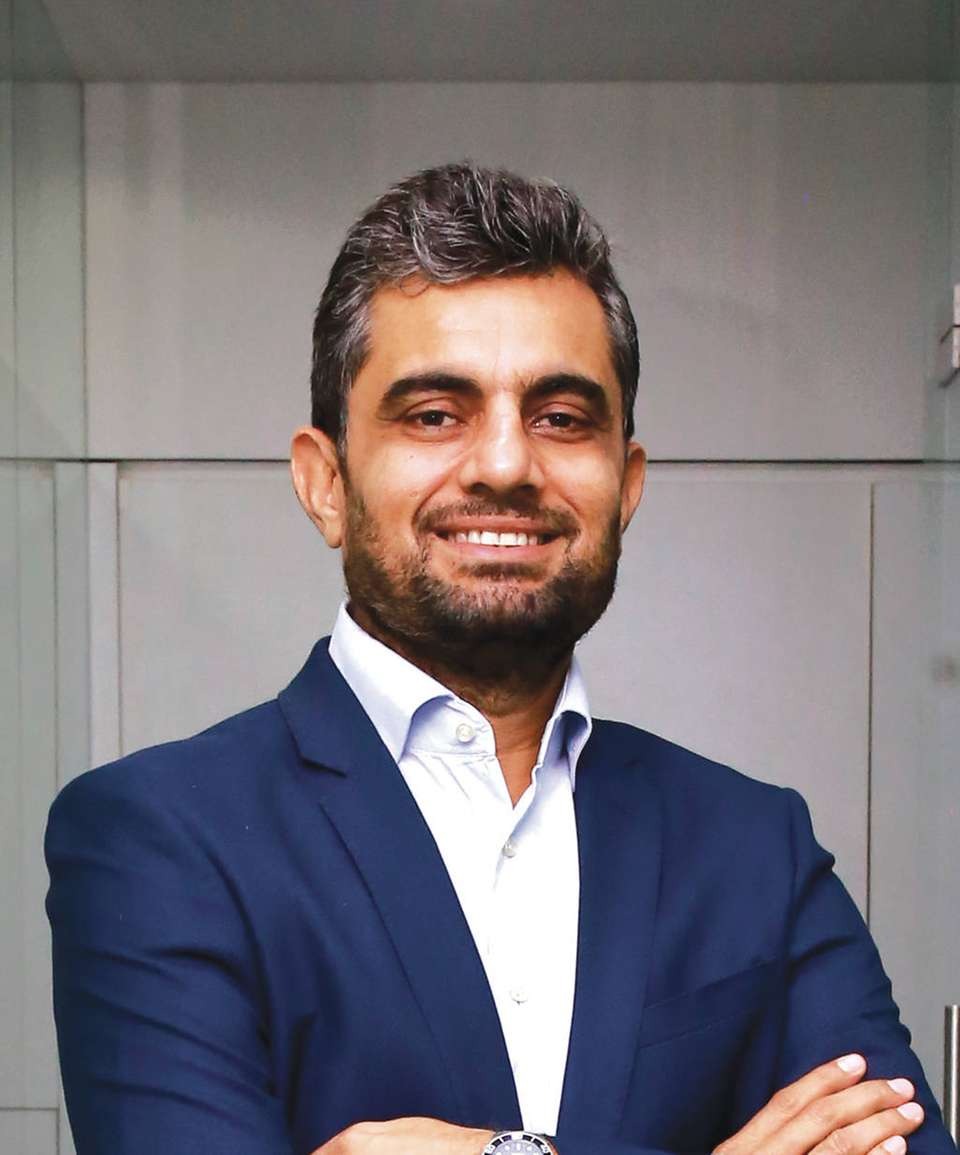3D-printed Boeing door-mode-handle covers

Straightforward scanning of printed parts for aircraft interiors Scanning spray improves 3D data capture
To prevent aeroplane doors being accidentally opened after landing, the door locks are secured with additional covers. For rapid availability of single parts and small batches, additive manufacturing – which does not generate any tool costs – is frequently used. A prerequisite for this is that both the material used and the company producing the parts must be authorised for production by the airline and the competent aviation authority. One certified manufacturer of aeroplane interior parts is the Singapore-based company AFS Additive Flight Solutions, which has an EASA POA 21.G certification and consequently produces components for a variety of airlines. Using specialised 3D printers, AFS produces for example door handle covers for a Boeing. The production process starts with data capture in order to prepare the part design.
Data capture in the aeroplane itself
To determine the required dimensions of the door-mode-handle cover, the locking lever to be covered is scanned in the aircraft itself. The challenge here is that the handle is anodised and silver-coloured. The slightly reflective surface is difficult for the scanner to capture. AFS therefore sprays the handle beforehand with a scanning spray in order to mat the surface and thus make it visible to the scanner. The scanning spray used is from AESUB. It can be easily and rapidly applied. Within a few seconds, a fine, homogenous layer is generated on the surface, and the part can be scanned immediately. A further important aspect of the use in aeroplanes is that the applied layer evaporates after just a short time. This means that neither the handle nor the aircraft interior need to be cleaned. “Because the AESUB spray evaporates so quickly, scans can take place in the aeroplane interior during line maintenance. With AESUB, optimum use can be made of this turnaround time. Because it does not contain any pigments, the spray poses no hazards to passengers, staff or users,” explains Stefan Röding, General Manager of Additive Flight Solutions, who uses the AESUB Spray for a variety of applications.

Using the data determined in the aeroplane, a design is developed for the cover. The prototype is printed. In order to guarantee accuracy of fit and functionality of the printed part, it is checked using the original door handle. If the part meets all specifications, then it is approved by the airline’s DOA (Design Organisation Approval), which must ensure that the parts meet the requirements for aviation. Small batch production is commenced.
3D printing with Ultem 9085 ™
For the 3D printing of the door handle covers, AFS uses high-quality Ultem 9085™ in black. Ultem 9085™ is specially designed for the manufacture of aircraft cabin parts and, due among other things to its high strength to weight ratio, fulfils the requirements for use in aeroplanes. Ultem 9085™ has a high impact resistance and chemicals tolerance . The high-performance thermoplastic is available in different colours.

Scanning spray for black parts
In order to check the dimensional accuracy, the printed parts are compared with the previously determined CAD data. Because black parts are difficult to scan, the covers were again sprayed with a AESUB scanning spray prior to the scanning process and thereby made visible. Here too, it is crucial to the subsequent manufacturing process that the spray evaporate automatically after the scanning process. Neither the parts nor the spraying environment have to be cleaned. Nor is the scanning equipment damaged by the spray layer. This is a crucial difference vis-à-vis many conventional sprays, which often adhere stubbornly to the parts and are very time-consuming and/or costly to remove. This has often resulted in damage to the manufactured parts which were consequently no longer usable. This is very costly, particularly in the case of high-quality materials such as ULTEM 9085™. With AESUB, no cleaning of the parts is required. The time and cost savings make the manufacturing process significantly more efficient.
Scan from all angles
So that the door handle covers matted with AESUB can be captured all the way round, they are held on a modular measuring frame for a complete 3D scan. Articulated brackets with tensioners hold the parts within the black frame so that they can be scanned from all angles. The reference points needed for scanning are placed not on the door handle covers but directly on the frame. This saves lots of time, particularly in the case of repeated measurement of single parts, as with short batches or pre-series production.
10-minute time-saving per part
The time-saving per part is approximately 10 minutes. Thus with a production run of 200 units, this represents a saving in working hours of at least a week. The modular frame is adapted to the size (height and width or diameter) of the measured object. By this means, the optimum distance from the measurement points to the measured object is maintained at all times.
Through the combination of the AESUB scanning spray and the modular measuring frame, the overall quality assurance process is accelerated significantly. Reliable information concerning the dimensional stability of the manufactured products is more rapidly available.
www.aesub.com




